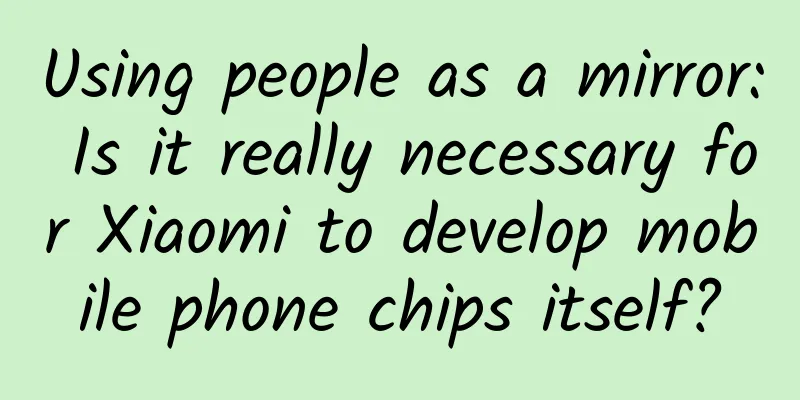Using people as a mirror: Is it really necessary for Xiaomi to develop mobile phone chips itself?

|
Recently, there have been a lot of news about Xiaomi designing its own mobile phone chips, and there have been countless comments, including supporters and opponents. What we want to say is, is it really necessary for Xiaomi to design its own mobile phone chips? First, let's take a look at the performance of Samsung, Apple, Huawei, and LG, the mobile phone companies that currently have independent chip design capabilities, in the mobile phone market. According to IDC's statistics on global smartphone shipments last year, Samsung is still the world's largest smartphone manufacturer, with shipments of 310 million units last year; Apple ranked second with shipments of 215 million units; Huawei shipped 140 million units, ranking third; LG shipped 75 million units, ranking sixth. In contrast, Xiaomi's shipments last year were only around 50-60 million units, and this year it is expected to decline to around 50 million units. It is not difficult to see from these statistics that the annual shipments of mobile phone manufacturers that currently design their own mobile phone chips are all above 60 million units. It should be noted that since LG is not as active as Apple, Samsung and Huawei in adopting its own chips, if it is excluded, then the starting shipments of mobile phone manufacturers that have the ability or can demonstrate the scale and cost advantages of their own chip design should be at least in the hundreds of millions. This leads to the first variable of Xiaomi's chip making, that is, whether Xiaomi's self-designed chips can bring it a significant cost reduction and savings scale effect as some industry analysts have said compared to using third-party chips remains to be discussed. It should be noted that even for the above-mentioned manufacturers with independent chip design capabilities, judging from their profitability, except for Apple, the profitability of Samsung and Huawei is not high, and LG is even in a loss-making state. This is closely related to product quality control (for example, Samsung Note7 "exploded" due to battery design defects) and marketing costs (Huawei's marketing costs were too high last year, resulting in a decrease in profits despite an increase in shipments and revenue), and has no direct relationship with whether or not they have independent chip design capabilities. In addition, looking at the above-mentioned manufacturers with independent chip design capabilities, they have also experienced shortages or out-of-stock situations for mobile phones during their development, but most of the reasons are not due to "chip shortages". After all, the mobile phone industry is an industry that involves a high degree of integration of many component supply chains. Problems in any link may lead to product delays or out-of-stock situations. Therefore, there are views that support Xiaomi's efforts to make independent chips. They believe that once Xiaomi makes its own chips, it will no longer face delays in mobile phone shipments due to third-party chip quality (for example, the previous Qualcomm 810 chip overheating caused the delay in the shipment of Xiaomi 5) or production capacity reasons. This view is just a blind spot, because improving the overall forecasting and management capabilities of the supply chain is the key. This also explains why Xiaomi CEO Lei Jun personally takes charge of supply chain management. In terms of size (such as the scale and capital of the enterprise), strength and accumulation, Xiaomi still has a huge gap with Apple, Samsung and Huawei, which have independent chip design capabilities. The chip industry's R&D has the characteristics of continuous high investment, long cycle and slow effect, which determines that even if Xiaomi barely launches a generation of chips, can the subsequent R&D investment continue? Especially in the current situation where Xiaomi is facing huge investment in marketing and channels (making up for the shortcomings before the lessons), there are also considerable variables. In addition, given the development of the above-mentioned manufacturers that have launched independent chips, it has proved that it takes at least two generations of products, or even multiple generations of trial and error and replacement to truly bring actual value to themselves (such as the failure of Huawei's first-generation HiSilicon K3 and the mediocre performance of Apple's first-generation A4 chip), but the reality of the market seems to have left no time window for Xiaomi to try and make mistakes. If the above is that Xiaomi has to make its own chips as a must and is far from meeting the many basic requirements for mobile phone manufacturers to make their own chips for their own mobile phone business, then the rapid rise of Chinese mobile phone manufacturers OV (OPPO and vivo) proves from another aspect that having independent chip design capabilities is not a must for mobile phone manufacturers. As we all know, the rapid rise of OV is inseparable from its precise marketing, the accumulation of traditional channels, and innovation targeting the mobile phone market and user pain points. These are not only the shortcomings that Xiaomi needs to adjust and make up for the most at the moment, but more importantly, compared with self-designed chips, the difficulty (including investment, non-chip-level functional innovation, etc.) is much smaller and the effect is faster. In fact, Xiaomi only needs to simply ask itself here: Does OV, which is in a rapid rise, know the importance of self-designed chips? Why don't they promote their own chips? Finally, let's look at the background of Xiaomi's promotion of self-designed mobile phone chips. In November 2014, Datang Telecom licensed the LC1860 platform of its wholly-owned subsidiary Unicore Technology to Pinecone Electronics, a company jointly established by Xiaomi and Unicore, for 103 million yuan. Since then, rumors have begun to circulate in the industry that Xiaomi is promoting its own designed chips. It should be noted that Pinecone Electronics employees are mainly diverted from Unicore employees, and the new company's packaging testing and wafer manufacturing are still entrusted to Datang Unicore. I wonder what the industry sees here? What we see is that the so-called Pinecone Electronics Company, which Xiaomi controls, still comes from Leadcore Technology (more like a "disguise" of Leadcore Technology) in terms of both its starting point for proprietary chip design technology and its personnel and resources for future development. It is a well-known fact that Leadcore Technology's technology maturity and scale are not as good as those of mainstream chip manufacturers, including Qualcomm, MediaTek, Samsung, Spreadtrum and HiSilicon. In addition, Xiaomi itself does not have the resources and accumulation for its own chip design. This seems to be destined that the level of Xiaomi's own chip design will not exceed that of Leadcore Technology at best. And given that Xiaomi was one of the mainstream mobile phone manufacturers cooperating with Leadcore Technology (the Redmi 2A series uses the LC1860 platform) and achieved sales of tens of millions (Xiaomi's Internet marketing model was in full swing at the time), what is the significance of this "changing the soup but not the medicine" (from Leadcore to Pinecone) approach now? As the saying goes: Using people as a mirror can help you understand your gains and losses. Specifically speaking of Xiaomi's own mobile phone chips, Xiaomi might as well look at the performance and strength of Apple, Samsung, and Huawei, which have their own mobile phone chip design capabilities; OV, which do not have their own mobile phone chip design capabilities, and Leadcore Technology, which has its own chip design sources. These companies, whether related to or not to chips, will naturally come to the conclusion of how necessary it is to personally handle mobile phone chips. As a winner of Toutiao's Qingyun Plan and Baijiahao's Bai+ Plan, the 2019 Baidu Digital Author of the Year, the Baijiahao's Most Popular Author in the Technology Field, the 2019 Sogou Technology and Culture Author, and the 2021 Baijiahao Quarterly Influential Creator, he has won many awards, including the 2013 Sohu Best Industry Media Person, the 2015 China New Media Entrepreneurship Competition Beijing Third Place, the 2015 Guangmang Experience Award, the 2015 China New Media Entrepreneurship Competition Finals Third Place, and the 2018 Baidu Dynamic Annual Powerful Celebrity. |
>>: Battery dilemma: a game that can’t be stopped
Recommend
How to attract new members and convert them into new members in the community?
As community operations are mentioned more and mo...
Affected by the epidemic, domestic smartphone shipments in Q1 may drop by 30%
The ongoing outbreak of the novel coronavirus is ...
Summary of unknown black hat SEO techniques
For website optimization SEO personnel, it is not...
6 design highlights to make fission activities successful!
Recently, a friend who works in operations compla...
The ancient tomb has been underground for thousands of years. Will the mechanism inside rust? The ancients thought of this long ago.
Previously, film, television and novel works abou...
Why can the induction cooker heat up the hot pot, but people’s hands don’t get hot when they put them on it?
When you go to a hotpot restaurant to eat hotpot,...
Real or Fake Monkey King? Sorry, I am actually a little orchid~
Auditing expert: Yang Yanhui, Senior Garden Engin...
Mobile games enter XBOX ONE? How far can the next generation of "TV boxes" go?
Whether it is the previous generation XBOX 360 or...
Academician Zhong Nanshan: During the epidemic, it is very important to protect your immunity!
Reviewer of this article: Chen Haixu, Deputy Dire...
Why are there no affordable ultrabooks?
When Intel announced the new concept of "Ultr...
A short-sighted geek buys breakfast and can "calculate" the price without even looking at the price list! ?
Many students feel confused and painful when they...
Douyin operation: New ways to play Douyin cover that you don’t know!
In fact, the Tik Tok cover is very helpful in inc...
I fell in the metaverse, it hurts so much!
The baby left the mother's body and came into...
Advertising cases in the automotive service industry!
In October this year, Shanghai's auto beauty ...
"Prince Diary" - School is back! What was written on the "leave note" over 3,000 years ago?
At the beginning of September, the autumn breeze ...








![300 fans can earn 1500 yuan a day. How to write articles that will make money as soon as they are published [paid articles]](/upload/images/67cc0fad908a5.webp)
